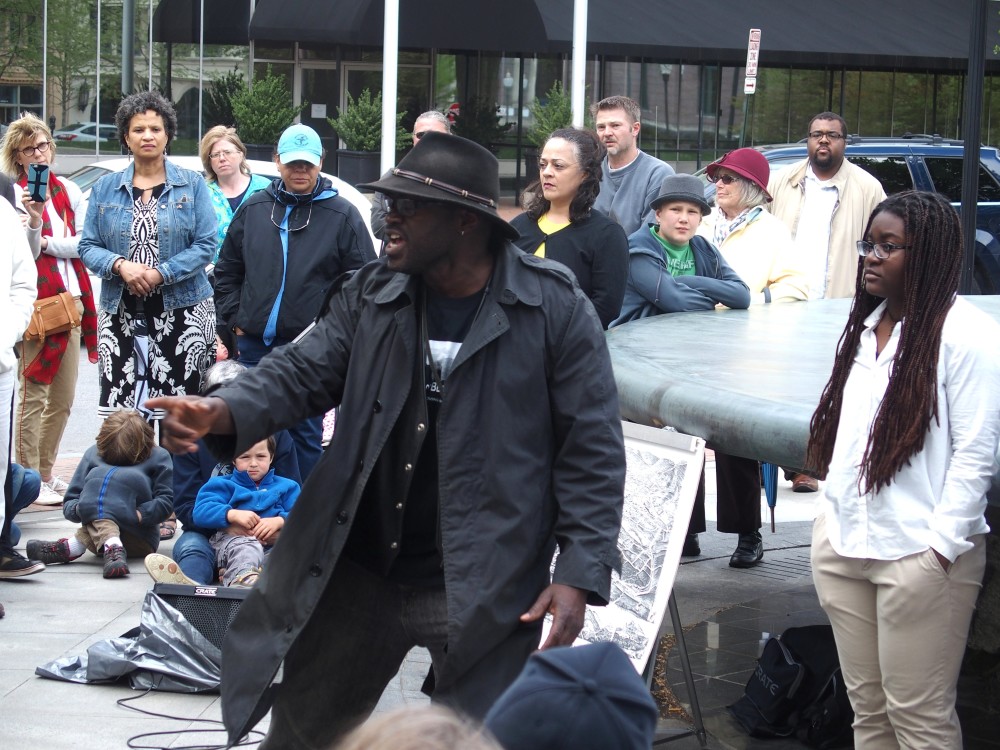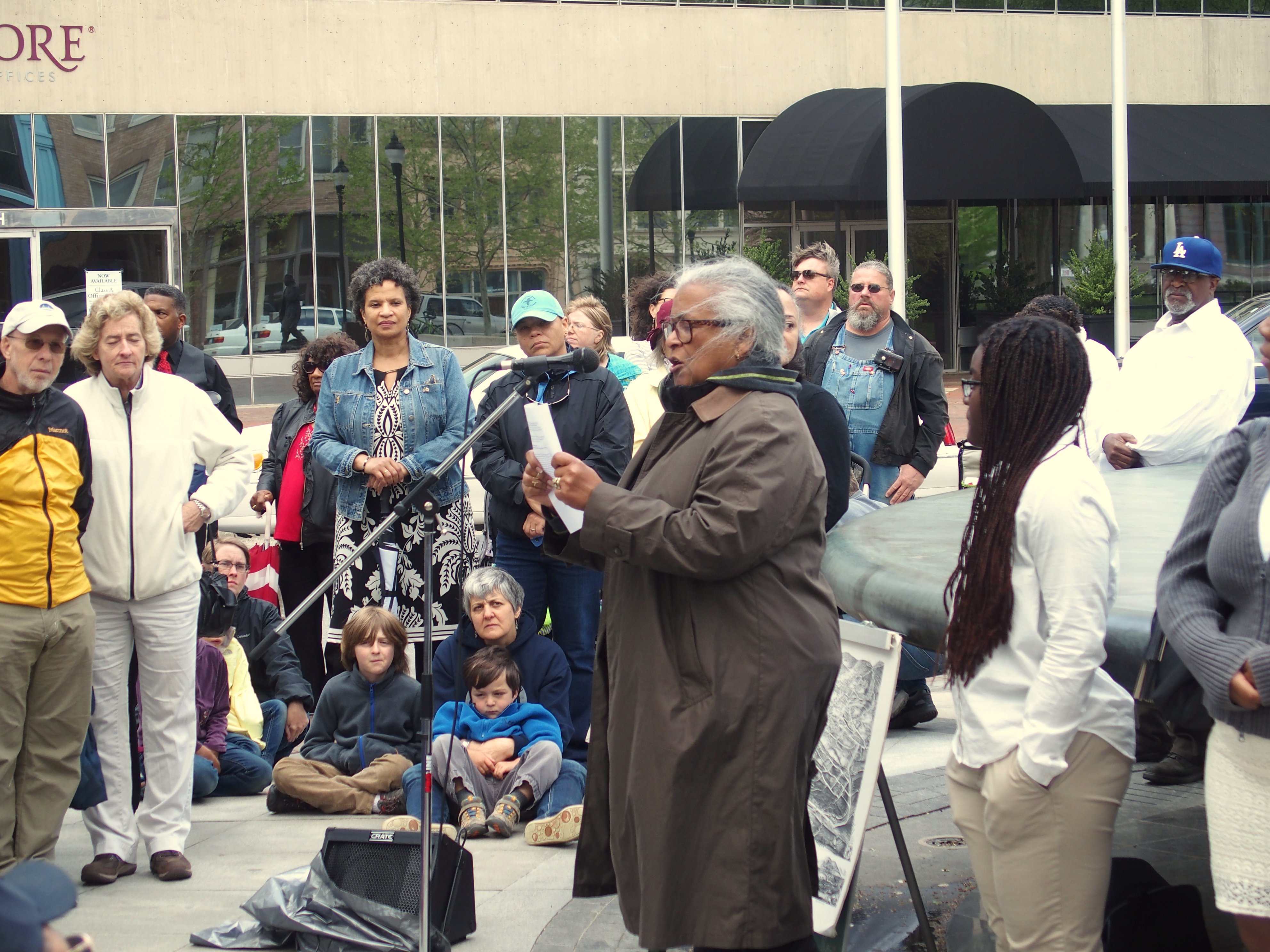


Locals gather to mark the end of slavery in Asheville and educate about oft-forgotten history at a site that’s still the topic of debate and controversy today
Above: local activist and poet DeWayne Barton speaks at the From Slavery to Freedom teach-in and event. Photo by Fred Meyer.
On Sunday, April 26, about 80 people gathered in Pack Square to mark 150 years since the end of slavery in Asheville. The event, including performances, speeches and a teach-in, was organized by Date my City and UNCA’s Center for Diversity Education.
“Two years after the Emancipation Proclamation, the Union Army of General George Stoneman, led by Brigadier General Alvan Gillem, approached Asheville on April 23, 1865,” Date My City leader (and Blade contributor) Sheneika Smith wrote in an explanation of the event’s history and purpose. “After signing a truce with the home guard, the general led 2,700 troops and hundreds of newly freed slaves along the Main Street of Asheville (now Biltmore Avenue). As they proceeded to leave town on April 26, the troops were joined by newly freed slaves from Asheville who sought safe passage out of the mountains to a new life elsewhere.”
Organizers plan to make the event, which Smith asserts is key to marking “this formerly silent history in our public spaces,” an annual one. It also comes at a time when the site it takes place on, the history around it, the city’s public spaces and Asheville’s own stories of slavery, liberation and segregation are a topic of increasing focus. The city is currently renovating the Vance Monument, dedicated to the state’s Confederate governor, an avowed racist and opponent of African-American rights. There are currently four other Confederate monuments nearby. There is also a push to build another monument in the area — where slave auctions likely took place — to mark the contributions of African-Americans to WNC.
“This liberation of enslaved blacks in Asheville by the Union soldiers is a complicated history for most,” Smith writes. “Rather than being remembered as an ‘Army of Liberation,’ historical markers refer to April 26, 1865 as ‘Stoneman’s Raid’ with a focus on the ransacking of the community by the soldiers as they exited the area. That is the kind of messiness that history, and heritage, require us to face.”
Below are some photos of the event along with eyewitness historical accounts, provided by the Center for Diversity Education, of Asheville’s liberation:

UNCA Professor Dwight Mullen speaking at the event. Photo by Fred Meyer.

Carmen Ramos-Kennedy, of the Mountain People’s Assembly, speaking at the event. Photo by Fred Meyer.
Eyewitness Accounts of April 23 – 26, 1865
Ms. Fannie Patton was the only surviving daughter of James W. Patton (1803-1861), a prominent Asheville businessman, owner of the Eagle Hotel and the developer of the railroad. Ms. Patton lived at the family home, The Henrietta, which stood about where The French Broad Coop stands today. The homes for enslaved people were in the area of the Public Works Garage.
April 25, 1865
“Well, they have passed quietly through – 2,700 men and numberless negro’s, horses and mules which they [have] stolen…..a great many negro’s have left town with the Yankee’s – crowds of men, women and children just gathered up a bundle of clothes and went with them. None of ours have gone, as we know of yet. John McDowell, a man belonging to me who ran away about two years ago, belonged to the Negro troops who were with them. Our men talked to him and he told them that he had been in the army since he left.”April 26, 1865 (written on May 11)
The morning that we saw the troops were going to move and also that a great many Negro’s were going to leave with them. About 20 of ours went off which, with those that had a gone a few days before, made 29. They left all Mother’s things open in the houses so we went down and brought up what we could of our clothes and vessels. When we got back, Margaret [a slave] told me that Uncle Joe had just brought out our dear old carriage….and he and Mammy and some of the other old women and children [all slaves] were going off in it.April 30 – May 4 (written May 11) Union officers occupied the front part of the Patton home.
“As soon as they left, all the servants, whom they had hired to wait on them, left the yard, except Margaret who said she was too sick to cook; so we had to do that and all the other work in the house. Brother cut the wood and made the fire and Nannie, Lizzie and I cooked dinner. The next day, we could hire no one so we had to cook again. The Negro’s were so elated at the idea of freedom that they would do no work at all; but they soon found out that they could no live on air and in a few days we had several applications to hire servants.”
According to historian John Inscoe in The Heart of Confederate Appalachia: Western North Carolina and the Civil War “Stoneman’s Raid had proved the single most liberating event of the war for mountain slaves, and even the slave holders not directly in the path of Union forces had found that they had lost much control of the slaves still with them.”
All of Mrs. J. W. Patton’s servants left her and went with the Yankees, not a single one of all she had remained to do a thing in the house or in the kitchen. They even took her beautiful carriage and, crowding into it, drove off in full possession.
Mary Taylor Brown to John Evans Brown,
June 20, 1865,pp. 18-19,W. Vance Brown Collection at Ramsey Library Special
Collections…In a remote corner of the place was a large frame house which had been set apart of the use of the wives and little children of some of the Negro men who had been hired to neighboring farmers; their payments [to the writer’s family] were paid in produce— bacon, wheat, corn, potatoes…. There were about twenty of them in all I think who were looked after, clothed fed and nursed when ill; they had plenty of firewood and were made as comfortable as was possible. I think none of this body of
Negroes left, as the Yankees passed through; whether they would not forsake their husbands; we could not tell; they at all events remained. The following The following day the troops began to file by; they passed just in front of our lawn; you, with the rest of the children accompanied by your nurses, went to a point where you could have a view of them in passing…It took a long while for these troops to pass. After they had all gone, it was discovered that your Aunt Emily’s two nurses, with several other Negroes in the neighborhood, had joined forces and gone off with the Yankees. Poor old Mammy and Altimore were terribly mortified and grieved at the evidence of ingratitude; but we realized it was the beginning of the general emancipation which would cause a complete revolution in our lives.Katherine Polk Gale,
“Recollections of Life in the Southern Confederacy,
1861-1865,” in the Gale and Polk Family Papers
#266, Southern Historical Collection, Wilson Library,
University of North Chapel Hill
—
The Asheville Blade is entirely funded by its readers. If you like our work, donate directly to us on Patreon. Questions? Comments? Email us.